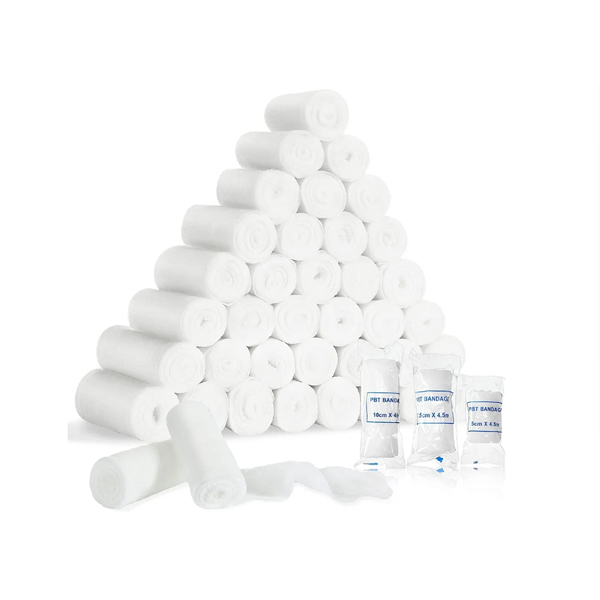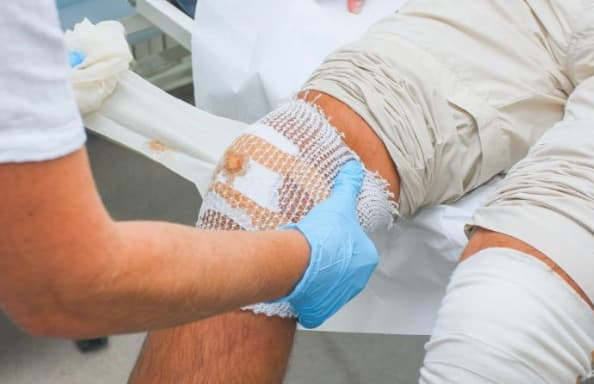เมื่อพูดถึงการสต็อกสินค้าในโรงพยาบาล คลินิก หรือโกดังเวชภัณฑ์ คำว่า "ผ้ากอซ" และ "ผ้าพันแผล" ถูกนำมาใช้อย่างต่อเนื่อง แต่พวกมันใช้แทนกันได้เหรอ? ไม่เลย. การทำความเข้าใจความแตกต่างเล็กน้อยแต่สำคัญระหว่างผ้ากอซและผ้าพันแผลเป็นพื้นฐานสำหรับการดูแลบาดแผลที่มีประสิทธิภาพ การจัดการสินค้าคงคลังที่เหมาะสม และการรับรองความปลอดภัยของผู้ป่วย สำหรับผู้จัดการฝ่ายจัดซื้ออย่าง Mark Thompson ในสหรัฐอเมริกาหรือผู้จัดจำหน่ายในยุโรป การจัดหาผลิตภัณฑ์ที่เหมาะสมสำหรับการใช้งานที่เหมาะสมเป็นสิ่งสำคัญยิ่ง บทความนี้ซึ่งดึงมาจากประสบการณ์ของผมในฐานะผู้ผลิตวัสดุสิ้นเปลืองทางการแพทย์แบบใช้แล้วทิ้งในประเทศจีน จะเปิดเผยหัวข้อนี้ เราจะสำรวจผ้าก๊อซประเภทต่างๆ การทำงานของผ้าพันแผล และวิธีการเลือกเวชภัณฑ์ที่ถูกต้องสำหรับสถานการณ์ทางคลินิก เพื่อให้มั่นใจว่าคุณจะตัดสินใจซื้อได้อย่างคุ้มต้นทุนและถูกต้องทางคลินิก
ผ้ากอซทางการแพทย์คืออะไรกันแน่ และเหตุใดจึงเป็นวัตถุดิบหลักในการดูแลบาดแผล?
โดยแก่นแท้แล้ว ผ้ากอซทางการแพทย์ เป็นเครื่องแต่งกายประเภทหนึ่งซึ่งโดยทั่วไปจะทำจากผ้าฝ้าย วัสดุสังเคราะห์ หรือวัสดุผสมเหล่านี้ จุดประสงค์หลักคือติดลงบนบาดแผลโดยตรง คิดว่ามันเป็นแนวป้องกันแรก โครงสร้างของ ผ้ากอซซึ่งมักเป็นผ้าทอหลวมหรือผ้าไม่ทอ ได้รับการออกแบบมาโดยเฉพาะสำหรับงานต่างๆ เช่น การดูดซับ การทำความสะอาด และการปกป้องบริเวณแผล ผ้าระบายอากาศได้ดีช่วยให้อากาศไหลเวียนได้ ซึ่งเป็นสิ่งสำคัญต่อกระบวนการบำบัด
มีหลายรูปแบบ ผ้ากอซแต่สิ่งที่พบบ่อยที่สุดที่คุณจะพบคือ แผ่นผ้ากอซ และ ผ้ากอซ ฟองน้ำ ก แผ่นผ้ากอซ เป็นชิ้นสี่เหลี่ยมหรือสี่เหลี่ยม ผ้ากอซมักบรรจุแบบปลอดเชื้อ พร้อมปกปิดและป้องกันบาดแผล เช่น บาดแผล รอยถลอก หรือแผลผ่าตัด หน้าที่หลักคือการดูดซับสารหลั่งจากบาดแผล (ของเหลว) และเป็นอุปสรรคที่สะอาดต่อการปนเปื้อน จากมุมมองของฉันในฐานะผู้ผลิตที่มีสายการผลิตเจ็ดสาย ความต้องการผ้าฝ้ายดูดซับคุณภาพสูง ผ้ากอซ แผ่นอิเล็กโทรดได้รับคะแนนสูงอย่างต่อเนื่องจากโรงพยาบาลและคลินิกทั่วอเมริกาเหนือและออสเตรเลีย ที่เรียบง่าย ผ้ากอซ แผ่นรองเป็นหนึ่งในสิ่งของที่มีประโยชน์หลากหลายและจำเป็นที่สุดในสถานพยาบาลทุกประเภท
แล้วผ้าพันแผลล่ะ? เป็นเพียงการคลุมผ้ากอซเท่านั้นหรือ?
ในขณะที่ก ผ้าพันแผล มักจะใช้ร่วมกับ ผ้ากอซแต่หน้าที่ของมันแตกต่างอย่างเห็นได้ชัด ก ผ้าพันแผล โดยทั่วไปไม่ได้หมายถึงการวางไว้บนแผลเปิดโดยตรง แต่บทบาทหลักคือการถือเครื่องแต่งตัวแทน (เช่น แผ่นผ้ากอซ) ในสถานที่ ให้การสนับสนุนบริเวณที่ได้รับบาดเจ็บ การบีบอัด หรือจำกัดการเคลื่อนไหว ก ผ้าพันแผล เป็นชั้นรองที่รักษาความปลอดภัยทุกอย่างและเพิ่มการป้องกันอีกระดับหนึ่ง
วัสดุที่ใช้สำหรับก ผ้าพันแผล แตกต่างกันไปขึ้นอยู่กับวัตถุประสงค์ ตัวอย่างเช่น ก ผ้าพันแผลยืดหยุ่น ได้รับการออกแบบมาเพื่อให้มีการบีบอัดเพื่อลดอาการบวมบริเวณข้อแพลงในขณะที่ลูกกลิ้งธรรมดา ผ้าพันแผล ทำจากผ้าฝ้ายใช้สำหรับยึดผ้าปิดแผลเป็นหลักโดยไม่ต้องใช้แรงกดมากนัก ประเด็นสำคัญก็คือในขณะนั้น ผ้ากอซ คือ การแต่งตัว ที่มีปฏิสัมพันธ์กับ แผล, ก ผ้าพันแผล เป็นเครื่องมือที่ใช้ยึดอาการบาดเจ็บไว้ด้วยกันหรือเก็บก การแต่งตัว ปลอดภัย เป็นวัสดุที่ใช้ในการยึดและรองรับในขณะที่ ผ้ากอซ เป็นวัสดุที่ใช้ปกปิดและดูดซับ

อะไรคือความแตกต่างที่สำคัญระหว่างผ้ากอซและผ้าพันแผล?
เพื่อให้มีข้อมูลในการตัดสินใจซื้อ จำเป็นอย่างยิ่งที่จะต้องเข้าใจอย่างชัดเจน ความแตกต่างระหว่างผ้ากอซ และผ้าพันแผล วิธีจำที่ง่ายที่สุดคือ: ผ้ากอซ คือ การแต่งตัว สำหรับ แผลและ ผ้าพันแผล มีไว้สำหรับการถือครอง การแต่งตัว หรือรองรับแขนขา พวกเขาทำหน้าที่เสริมแต่มีบทบาทแยกกัน การดูแลบาดแผล. มาแจกแจงความแตกต่างที่สำคัญในตารางง่ายๆ กัน
| คุณสมบัติ | ผ้ากอซ | ผ้าพันแผล |
|---|---|---|
| การใช้งานหลัก | เป็นแผลหลัก การแต่งตัว; สำหรับทำความสะอาด บรรจุ และดูดซับสารหลั่ง | ที่จะถือ การแต่งตัว ในสถานที่; ให้การสนับสนุน การบีบอัด หรือจำกัดการเคลื่อนไหว |
| วัสดุ | โดยปกติแล้ว ผ้าฝ้าย, เส้นใยสังเคราะห์ (เรยอน โพลีเอสเตอร์) หรือผ้าผสม สามารถทอหรือ ไม่ทอ. | อาจเป็นยางยืด ผ้า เทปกาว หรือผ้าฝ้าย ไม่ได้ออกแบบมาเพื่อการดูดซึม |
| ติดต่อกับบาดแผล | ใช่ ออกแบบมาเพื่อการสัมผัสโดยตรงกับ แผล เตียง | ไม่ ปกติแล้วจะไม่ถูกวางไว้บนที่เปิดโดยตรง แผล. มันไปมากกว่า การแต่งตัว. |
| แบบฟอร์ม | แผ่นผ้ากอซ,ฟองน้ำ,ม้วน,แถบ. | ม้วนที่มีความกว้างและวัสดุต่างกัน แถบกาว ผ้าพันแผลสามเหลี่ยม |
| ฟังก์ชั่นที่สำคัญ | การดูดซึม, การป้องกัน, การ debridement. | การรักษาความปลอดภัย การสนับสนุน การบีบอัด. |
ความแตกต่างนี้เป็นสิ่งสำคัญ การใช้ก ผ้าพันแผล โดยตรงบน แผล อาจทำให้เส้นใยเกาะติด ทำให้เกิดความเจ็บปวดและความเสียหายของเนื้อเยื่อเมื่อนำออก ในทางกลับกัน ใช้เพียงชิ้นเดียวเท่านั้น ผ้ากอซ การพยุงข้อเท้าแพลงจะไม่ได้ผล การรวมกันของ ผ้ากอซและผ้าพันแผล เป็นสิ่งที่สร้างความสมบูรณ์และมีประสิทธิภาพ วัสดุปิดแผล ระบบ การทำความเข้าใจพื้นฐานนี้ ผ้าพันแผลกับ ผ้ากอซ หลักการทำให้มั่นใจได้ว่าผู้เชี่ยวชาญทางการแพทย์มีเครื่องมือที่เหมาะสมสำหรับทุกสถานการณ์ ตั้งแต่การปฐมพยาบาลเบื้องต้นจนถึงการดูแลหลังการผ่าตัด
ผ้ากอซแบบทอกับผ้าไม่ทอ: อะไรที่เหมาะกับบาดแผล?
ดำดิ่งลึกเข้าไปในโลกของ ผ้ากอซความแตกต่างที่สำคัญที่สุดประการหนึ่งคือระหว่าง ผ้ากอซทอและไม่ทอ. ในฐานะผู้ผลิต เราผลิตทั้งสองประเภทเพราะตอบสนองความต้องการที่แตกต่างกันค่ะ การดูแลบาดแผล. ทางเลือกระหว่างพวกเขาขึ้นอยู่กับข้อกำหนดเฉพาะของ แผล.
ผ้ากอซทอ เป็นชนิดดั้งเดิมที่ทำมาจาก 100% ผ้าฝ้าย เส้นใยที่ถักทอกันเหมือนผ้าผืนหนึ่ง นี้ สาน ให้ความแข็งแรงและทนทานเป็นเลิศ เพราะเนื้อผ้าที่ทอ ผ้ากอซ เหมาะอย่างยิ่งสำหรับงานอย่างเช่นบาดแผล การ debridement (ขจัดเนื้อเยื่อที่ตายแล้ว) หรือสำหรับปิดแผลลึก มันเปิดอยู่ สาน โครงสร้างทำให้ดูดซับได้ค่อนข้างมาก แต่บางครั้งอาจทำให้เกิดขุยหรือเส้นใยทิ้งไว้ได้ แผล เตียงซึ่งเป็นข้อพิจารณาสำคัญ
ผ้ากอซไม่ทอในทางกลับกัน โดยทั่วไปจะทำมาจาก เส้นใยสังเคราะห์ เช่น โพลีเอสเตอร์หรือเรยอน ซึ่งถูกอัดเข้าด้วยกันแทนที่จะทอ โครงสร้างนี้ส่งผลให้วัสดุโดยทั่วไปสามารถดูดซับได้ดีกว่าเมื่อเปรียบเทียบกับผ้าทอ ผ้ากอซ. ข้อได้เปรียบที่สำคัญของ ผ้ากอซไม่ทอ ก็คือว่ามันผลิต ผ้าสำลีน้อยลงทำให้เป็นทางเลือกที่ปลอดภัยกว่าสำหรับแผลเปิดที่มีปัญหาการปนเปื้อนของเส้นใย ก็ยังมี ดีกว่า wicking คุณสมบัติ หมายถึง ดึงของเหลวออกจากตัว แผล พื้นผิวได้อย่างมีประสิทธิภาพมากขึ้น ความรู้สึกมักจะนุ่มนวลกว่าและมีแนวโน้มที่จะปรับเข้ากับส่วนโค้งของร่างกายได้ง่ายกว่า

คุณจะเลือกผ้ากอซชนิดที่เหมาะสมสำหรับบาดแผลต่างๆ ได้อย่างไร?
การเลือกสิ่งที่ถูกต้อง ผ้ากอซ ถือเป็นก้าวสำคัญสำหรับ การดูแลบาดแผลอย่างมีประสิทธิภาพ. การตัดสินใจขึ้นอยู่กับประเภทของ แผล, จำนวน สารหลั่งและเป้าหมายของการ การแต่งตัว. สำหรับการตัดหรือขูดแบบง่ายๆด้วย เบาถึงปานกลาง เลือดออกเป็นมาตรฐาน หมัน แผ่นผ้ากอซ หรือ ผ้ากอซสำลีดูดซับ เหมาะอย่างยิ่ง ทำให้เกิดสิ่งกีดขวางที่สะอาดและเพียงพอ การดูดซึม เพื่อจัดการของเหลว
สำหรับสถานการณ์ที่ซับซ้อนมากขึ้น ตัวเลือกจะมีความเหมาะสมยิ่งขึ้น สำหรับ บาดแผลลึก ที่ต้องบรรจุเพื่อส่งเสริมการรักษาจากภายในสู่ภายนอกแบบทอ ผ้ากอซ มักนิยมใช้แถบเนื่องจากความแข็งแรงและโครงสร้าง เมื่อต้องรับมือกับการหลั่งไหลออกมาอย่างหนัก แผล,แบบหลายชั้น การแต่งตัว ด้วยความสูงมาก ดูดซับ ผ้ากอซไม่ทอ เนื่องจากชั้นแรกมีประสิทธิภาพมากกว่า ประเภทนี้ ผ้ากอซ จะดึงความชื้นออกจากตัว แผลป้องกันไม่ให้ผิวโดยรอบเปื่อย (นุ่ม และแตกตัวจากความชื้นที่มากเกินไป) สำหรับผิวแพ้ง่ายหรือบาดแผลที่บอบบาง ความนุ่มนวลของ ผ้ากอซไม่ทอ ยังสามารถให้ความสะดวกสบายแก่ผู้ป่วยได้มากขึ้น ก แพทย์มืออาชีพ มักจะทำการโทรครั้งสุดท้าย แต่ในฐานะซัพพลายเออร์ที่ให้บริการช่วงของ ประเภทต่างๆ ของ ผ้ากอซ เป็นสิ่งจำเป็น
เมื่อใดที่ผ้าพันแผลจะเป็นทางเลือกที่ดีกว่าการใช้ผ้ากอซ?
A ผ้าพันแผล เป็นเครื่องมือในการเลือกเมื่อเป้าหมายหลักไม่ใช่การดูดซึม แต่เป็นการสนับสนุน การบีบอัดหรือรักษาความปลอดภัยรายการอื่น เช่น หากผู้ป่วยมีข้อมือแพลง ผ้าพันแผลยืดหยุ่น ใช้สำหรับพันข้อต่อ มีวัตถุประสงค์เพื่อลดอาการบวมและให้ความมั่นคง ก ผ้ากอซ การแต่งตัว จะไม่ให้การสนับสนุนเชิงโครงสร้างในสถานการณ์นี้
A ผ้าพันแผล ก็เป็นสิ่งจำเป็นสำหรับเช่นกัน การรักษาความปลอดภัยน้ำสลัด. หลังจากก หมัน แผ่นผ้ากอซ ถูกวางไว้เหนือก แผล,ลูกกลิ้ง ผ้าพันแผล หรือใช้เทปกาวยึดให้แน่นอยู่กับที่ สิ่งนี้จะป้องกันไม่ให้ ผ้ากอซ จากการขยับตัวซึ่งอาจเผยให้เห็น แผล เพื่อปนเปื้อนหรือรบกวน กระบวนการบำบัด. ที่ ผ้าพันแผล ทำหน้าที่เป็นเกราะป้องกันชั้นนอก ปกป้อง ผ้ากอซ และ แผล ข้างใต้จากสิ่งสกปรกและการเสียดสี ในกรณีที่เกี่ยวข้องกับการบาดเจ็บขนาดใหญ่ ก ผ้าพันแผล อาจใช้สำหรับพันแขนขาทั้งหมดเพื่อยึดหลาย ๆ อัน แผ่นผ้ากอซ หรือเฝือกอย่างแน่นหนา ที่สำคัญก็คือ ผ้าพันแผล ทำงาน ด้วย ที่ การแต่งตัวไม่ใช่แทนที่มัน

ผ้ากอซสามารถใช้โดยไม่มีผ้าพันแผลได้หรือไม่? ทำความเข้าใจเรื่องการแต่งกายระดับประถมศึกษาและมัธยมศึกษา
ใช่ ผ้ากอซ บางครั้งสามารถใช้งานได้โดยไม่ต้องใช้ลูกกลิ้งแบบเดิม ผ้าพันแผลแต่โดยปกติแล้วก็ยังต้องมีการรักษาความปลอดภัย นี่เป็นการแนะนำแนวคิดเรื่องประถมศึกษาและมัธยมศึกษา วัสดุปิดแผล ชั้น ประถมศึกษา การแต่งตัว คือชั้นที่สัมผัสโดยตรงกับ แผล ตัวมันเอง ก แผ่นผ้ากอซ เป็นตัวอย่างที่สมบูรณ์แบบของประถมศึกษา การแต่งตัว. หน้าที่ของมันคือ ดูดซับสารหลั่ง และปกป้อง แผล เนื้อเยื่อ
รอง การแต่งตัว คือชั้นที่อยู่เหนือชั้นปฐมภูมิ การแต่งตัว เพื่อยึดให้อยู่กับที่และให้การปกป้องเพิ่มเติม นี่คือที่ก ผ้าพันแผล มักจะเข้ามา แต่ในบางกรณีก็มีกาวติดอยู่ แผ่นผ้ากอซ สามารถทำหน้าที่เป็นทั้งสองอย่างได้ แผ่นเหล่านี้มี กาว ขอบที่เกาะติดกับผิวหนัง รอบแผลโดยยึดตัวดูดซับส่วนกลางไว้ แผ่นผ้ากอซ โดยไม่จำเป็นต้องแยกจากกัน การห่อ. ในทำนองเดียวกันผลิตภัณฑ์เช่น สำลีทางการแพทย์ ใช้สำหรับทำความสะอาด แผล ด้วย รับบิ้งแอลกอฮอล์ หรือ น้ำยาฆ่าเชื้อ ครีม ก่อนใดๆ ผ้ากอซ หรือ ผ้าพันแผล ถูกนำมาใช้ด้วยซ้ำ ระบบของ การดูแลบาดแผล เกี่ยวข้องกับหลายขั้นตอน และการทำความเข้าใจบทบาทของแต่ละส่วนประกอบ ตั้งแต่เครื่องมือทำความสะอาดไปจนถึงการตกแต่งขั้นพื้นฐานและรองถือเป็นสิ่งสำคัญ
ผู้จัดการฝ่ายจัดซื้อควรมองหาอะไรในผ้ากอซและผ้าพันแผลคุณภาพสูง
สำหรับลูกค้าของฉัน ไม่ว่าพวกเขาจะเป็นเจ้าหน้าที่จัดซื้อสำหรับหน่วยงานด้านการดูแลสุขภาพของรัฐบาลหรือผู้จัดจำหน่ายที่จัดหาบ้านพักคนชราส่วนตัว เกณฑ์การจัดซื้อจะเน้นที่คุณภาพ การปฏิบัติตามข้อกำหนด และความน่าเชื่อถือเป็นหลักเสมอ เมื่อจัดหา ผ้ากอซทางการแพทย์ และผ้าพันแผล มีหลายปัจจัยที่ต้องพิจารณา ขั้นแรก ให้ประเมินวัสดุ สำหรับ ผ้ากอซฝ้ายมองหาความบริสุทธิ์ 100% ผ้าฝ้าย สูงสุด การดูดซึม และความนุ่มนวล สำหรับ ผ้ากอซไม่ทอ,สอบถามข้อมูลเฉพาะ เส้นใยสังเคราะห์ ที่ใช้และคุณลักษณะด้านประสิทธิภาพ เช่น ความสามารถในการดูดซับและการหลุดของเส้นใย (ผ้าสำลีน้อยลง).
การปฏิบัติตามกฎระเบียบไม่สามารถเจรจาต่อรองได้ ในฐานะโรงงานที่ส่งออกไปยังสหรัฐอเมริกา ยุโรป และออสเตรเลีย เรารู้ว่าการรับรอง เช่น ISO 13485 และเครื่องหมาย CE ถือเป็นสิ่งสำคัญ เรารับรองว่าเอกสารของเรามีความโปร่งใสและตรวจสอบได้ง่ายเพื่อแก้ไขปัญหาสำคัญประการหนึ่งสำหรับผู้ซื้อจากต่างประเทศ: การตรวจสอบความถูกต้องของซัพพลายเออร์ นอกจากนี้ ให้พิจารณาถึง ความเป็นหมัน. รับรองว่า หมัน ผลิตภัณฑ์ได้รับการบรรจุอย่างเหมาะสมเพื่อรักษาความสมบูรณ์จนถึงจุดใช้งาน การตรวจสอบย้อนกลับเป็นชุดเป็นอีกปัจจัยสำคัญ ในกรณีที่เกิดปัญหาด้านคุณภาพ ความสามารถในการติดตามผลิตภัณฑ์กลับไปยังล็อตการผลิตถือเป็นสิ่งสำคัญอย่างยิ่งต่อความปลอดภัยของผู้ป่วยและการบริหารความเสี่ยง สุดท้ายนี้ กำลังการผลิตของซัพพลายเออร์และประสิทธิภาพด้านลอจิสติกส์เป็นกุญแจสำคัญในการป้องกันความล่าช้าในการจัดส่งและการขาดแคลนอุปทาน ซึ่งเป็นข้อกังวลอย่างต่อเนื่องในภาคการดูแลสุขภาพ

ความสำคัญของความเป็นหมัน: ผ้ากอซและผ้าพันแผลที่ปราศจากเชื้อและไม่ผ่านการฆ่าเชื้อ
ความแตกต่างระหว่าง หมัน และ ไม่ผ่านการฆ่าเชื้อ ผลิตภัณฑ์ถือเป็นหนึ่งในสิ่งที่สำคัญที่สุดในขอบเขตของ เวชภัณฑ์. ผ้ากอซฆ่าเชื้อ ได้รับการบำบัดด้วยกระบวนการ (เช่น ก๊าซเอทิลีนออกไซด์ การแผ่รังสี หรือไอน้ำ) ที่ฆ่าเชื้อจุลินทรีย์ทั้งหมด มันถูกบรรจุแยกกันเพื่อรักษาสิ่งนี้ ความเป็นหมัน. ปลอดเชื้อ ผ้ากอซ จำเป็นอย่างยิ่งสำหรับทุกสถานการณ์ที่ผิวหนังถูกทำลาย เช่น แผลเปิด ขั้นตอนการผ่าตัด หรือการแต่งกาย แผล. การใช้ ไม่ผ่านการฆ่าเชื้อ ผ้ากอซ ในกรณีเหล่านี้จะแนะนำแบคทีเรียและก่อให้เกิดความเสี่ยงอย่างมากต่อการติดเชื้อ
ผ้ากอซที่ไม่ผ่านการฆ่าเชื้อซึ่งมักขายเป็นม้วนหรือบรรจุภัณฑ์จำนวนมาก มี "ความสะอาด" แต่ไม่ปราศจากจุลินทรีย์ มันเหมาะอย่างยิ่งสำหรับการใช้งานที่ไหน ความเป็นหมัน ไม่จำเป็น ตัวอย่างเช่น สามารถใช้ทำความสะอาดผิวหนังที่สมบูรณ์ ใช้ขี้ผึ้ง กันกระแทกสำหรับเฝือก หรือใช้เป็นรอง การแต่งตัว เลเยอร์บน หมัน ชั้นหลัก การทำความเข้าใจความแตกต่างนี้เป็นสิ่งสำคัญสำหรับทั้งความปลอดภัยของผู้ป่วยและการจัดการต้นทุน การจัดซื้อจำนวนมาก ไม่ผ่านการฆ่าเชื้อ ผ้ากอซ สำหรับแอปพลิเคชันที่ไม่ต้องการ ความเป็นหมัน ประหยัดกว่าการใช้แบบแยกบรรจุมาก หมัน แผ่นอิเล็กโทรด สิ่งอำนวยความสะดวกที่มีสต๊อกไว้อย่างดีต้องการทั้งสองตัวเลือกเพื่อให้บริการที่ครอบคลุมและ แผลที่มีประสิทธิภาพ การดูแล
ร่วมมือกับผู้ผลิตที่เชื่อถือได้: คำตอบสุดท้ายเกี่ยวกับเวชภัณฑ์ของคุณ
เมื่อถึงเวลา การดูแลบาดแผลคุณภาพของวัสดุที่คุณใช้สามารถส่งผลโดยตรงต่อผลลัพธ์ของผู้ป่วย ที่ ความแตกต่างระหว่างผ้าพันแผลทางการแพทย์ และ ผ้ากอซ เป็นมากกว่าคำศัพท์เฉพาะ มันเกี่ยวกับฟังก์ชัน การใช้งาน และความปลอดภัย จาก สาน ของ ผ้ากอซฝ้าย ม้วนไปตามความยืดหยุ่นของการบีบอัด ผ้าพันแผลทุกรายละเอียดมีความสำคัญ ในขณะที่คุณจัดหาสิ่งจำเป็นเหล่านี้ ทางการแพทย์แบบใช้แล้วทิ้ง ผลิตภัณฑ์จากความเรียบง่าย แผ่นผ้ากอซ ไปจนถึงชุด PPE แบบครบวงจร เช่น ชุดแยกการร่วมมือกับผู้ผลิตที่เข้าใจถึงความแตกต่างเหล่านี้เป็นสิ่งสำคัญ
ในฐานะเจ้าของโรงงาน ฉัน Allen ยืนหยัดในคุณภาพและการปฏิบัติตามกฎระเบียบของผลิตภัณฑ์ของเรา เรารู้ว่ามืออาชีพอย่าง Mark Thompson ต้องการอะไร: ประสิทธิภาพที่เชื่อถือได้ ราคาที่แข่งขันได้ และห่วงโซ่อุปทานที่โปร่งใสและมีประสิทธิภาพ ไม่ว่าคุณจะซื้อก ม้วนผ้าพันแผลผ้ากอซทางการแพทย์ หรือทันตกรรม ผ้าฝ้าย rolls การเลือกซัพพลายเออร์ที่มีความเชี่ยวชาญที่ได้รับการพิสูจน์แล้วและความมุ่งมั่นต่อมาตรฐานระดับโลกเป็นวิธีที่ดีที่สุดเพื่อให้แน่ใจว่าสถานประกอบการของคุณพร้อมเสมอที่จะให้การดูแลในระดับสูงสุด
ประเด็นสำคัญ
- ผ้ากอซเป็นน้ำสลัด: บทบาทหลักคือการสัมผัสบาดแผลโดยตรงเพื่อดูดซับของเหลว ทำความสะอาด หรือพันแผล
- ผ้าพันแผลมีไว้สำหรับการสนับสนุน: วัตถุประสงค์หลักคือเพื่อยึดผ้าปิดแผลให้เข้าที่ บีบอัด หรือพยุงแขนขาที่ได้รับบาดเจ็บ
- วัสดุที่แตกต่างกัน: ผ้ากอซ โดยทั่วไปจะทำจากวัสดุดูดซับ เช่น ผ้าฝ้ายหรือผ้าผสมสังเคราะห์ ในขณะที่ผ้าพันแผลทำจากวัสดุอย่างยางยืดหรือผ้าธรรมดาเพื่อการรองรับ
- ผ้ากอซทอกับผ้าไม่ทอ: ทอ ผ้ากอซ มีความแข็งแรงและดีต่อการขัดถูในขณะเดียวกัน ผ้ากอซไม่ทอ ดูดซับได้มากกว่าและทำให้เกิดขุยน้อยลง
- ความปลอดเชื้อเป็นสิ่งสำคัญ: ใช้ ผ้ากอซหมัน สำหรับแผลเปิดเพื่อป้องกันการติดเชื้อ ผ้ากอซที่ไม่ผ่านการฆ่าเชื้อ เหมาะสำหรับทาบนผิวหนังที่สมบูรณ์หรือเป็นชั้นรอง
- เลือกซัพพลายเออร์อย่างชาญฉลาด: ร่วมมือกับผู้ผลิตที่สามารถจัดหาผลิตภัณฑ์คุณภาพสูงที่ผ่านการรับรอง และแสดงให้เห็นถึงห่วงโซ่อุปทานที่เชื่อถือได้เพื่อตอบสนองความต้องการของคุณ
เวลาโพสต์: 22 ส.ค.-2025





